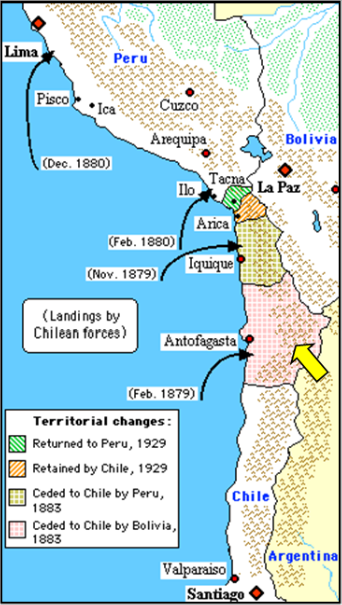 xxxxxThe so-called “War of the Pacific”, was fought from 1879 to 1884 between Chile and the combined forces of Peru and Bolivia. The major cause of the war was over the mineral-rich region of Atacama (arrowed on map), though, as in many parts of South America at this time, there were also a number of bitter disputes over the exact location of state boundaries. By an agreement made in 1874, Bolivia - then in control of the Atacama Region - had allowed Chilean companies to continue to extract nitrate on payment of an agreed tax, fixed over the next 25 years. However, just four years later the Bolivian president Hilarion Daza, coming to power in 1876 and short of funds, rescinded the agreement and levied fresh taxes. When Chile objected, he threatened to take control of the Chilean Nitrate Company based at Antofagasta. In response, in February 1879 Chile despatched a military force to occupy the port and nearby nitrate mines, and this sparked off the conflict. Bolivia declared war on Chile on the first day of March and, by means of a secret defence treaty drawn up in 1873, was joined by a somewhat reluctant Peru.
xxxxxThe so-called “War of the Pacific”, was fought from 1879 to 1884 between Chile and the combined forces of Peru and Bolivia. The major cause of the war was over the mineral-rich region of Atacama (arrowed on map), though, as in many parts of South America at this time, there were also a number of bitter disputes over the exact location of state boundaries. By an agreement made in 1874, Bolivia - then in control of the Atacama Region - had allowed Chilean companies to continue to extract nitrate on payment of an agreed tax, fixed over the next 25 years. However, just four years later the Bolivian president Hilarion Daza, coming to power in 1876 and short of funds, rescinded the agreement and levied fresh taxes. When Chile objected, he threatened to take control of the Chilean Nitrate Company based at Antofagasta. In response, in February 1879 Chile despatched a military force to occupy the port and nearby nitrate mines, and this sparked off the conflict. Bolivia declared war on Chile on the first day of March and, by means of a secret defence treaty drawn up in 1873, was joined by a somewhat reluctant Peru.
xxxxxAnxious above all to make secure its trade in nitrate, Chile wasted no time in going onto the offensive. Its navy won resounding victories against the Peruvians at Iquique in May 1879 and Cape Angamos in the October - capturing the ironclad Huascar in the process - and this gave Chile compete command of the coastal waters. This enabled an invasion and occupation of the rich mineral province of Tarapaca in November 1879, and an attack upon Tacna and Arica early in the New Year. These valuable nitrate provinces were occupied following two land battles. Chileanxtroops defeated the allies at the Battle of Campo de la Alianza in the May, and, following a protracted naval engagement, gained a decisive victory over the Peruvians at the Battle of Arica the following month (illustrated below). By this stage the Bolivian army had moved inland to defend the country’s interior, and Peru was left to continue the war alone.
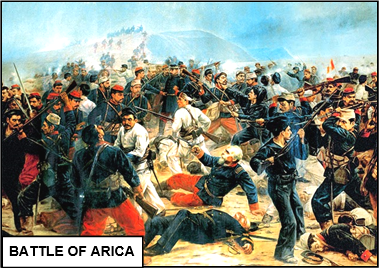 xxxxxIn December 1880 Chile renewed its military offensive by launching another seaborne attack upon Peru. Approaching Lima early in January 1881, the Chilean army defeated the Peruvians at the Battles of Chorrillos and Miraflores. Their army fled in disorder and the capital city was occupied on the 17th. The Peruvian government was forced to retreat into the highland interior. There followed two years of guerrilla warfare based on this mountainous region, but eventually Peru agreed to make peace. Byxthe Treaty of Ancon, signed in October 1883, Peru lost the province of Tarapaca, and Chile was allowed to continue its occupation of Tacna and Arica for a period of ten years, after which sovereignty would be finally settled by a plebiscite. Atxa truce signed at Valparaiso in April the following year, Bolivia ceded its only coastal region of Atacama Province to Chile - thus becoming a landlocked country - and this agreement was confirmed in 1904 under a Treaty of Peace and Friendship. In return, Chile guaranteed the Bolivians freedom of transport to ports on their Pacific coast.
xxxxxIn December 1880 Chile renewed its military offensive by launching another seaborne attack upon Peru. Approaching Lima early in January 1881, the Chilean army defeated the Peruvians at the Battles of Chorrillos and Miraflores. Their army fled in disorder and the capital city was occupied on the 17th. The Peruvian government was forced to retreat into the highland interior. There followed two years of guerrilla warfare based on this mountainous region, but eventually Peru agreed to make peace. Byxthe Treaty of Ancon, signed in October 1883, Peru lost the province of Tarapaca, and Chile was allowed to continue its occupation of Tacna and Arica for a period of ten years, after which sovereignty would be finally settled by a plebiscite. Atxa truce signed at Valparaiso in April the following year, Bolivia ceded its only coastal region of Atacama Province to Chile - thus becoming a landlocked country - and this agreement was confirmed in 1904 under a Treaty of Peace and Friendship. In return, Chile guaranteed the Bolivians freedom of transport to ports on their Pacific coast.
xxxxxIncidentally, the plebiscite concerning the provinces of Tacna and Arica, due in 1893, never took place amid accusations of vote rigging. This “Question of the Pacific”, as the dispute came to be known, was finally settled in 1929 through the mediation of the United States. Chile retained Arica, but Peru regained Tacna, as the map shows. ……
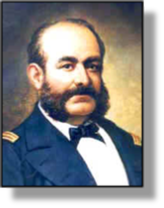
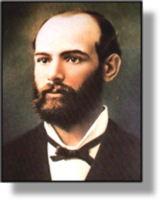 xxxxx…… Duringxthe war two naval officers won immortal fame for their bravery and devotion to duty. Admiral Miguel Grau (1834-1879) (illustrated left), captain of the ill-fated Peruvian ironclad Huascar, distinguished himself during the Battle of Iquique, and gained respect for the kindness and mercy he showed towards the enemy. Known as “the Gentleman of the Seas” he was killed when his ship was attacked and captured at the Battle of Angamos in 1879. In the year 2000 he was voted “Peruvian of the Millennium” by a grateful public. Onexof the ships Grau rammed and sank during the Battle of Iquique was the Chilean corvette Esmiraldo, captained by Arturo Prat (1848-1879) (illustrated right). He is remembered today for his outstanding bravery. When the Huascar, rammed his ship, he jumped aboard the enemy vessel and, wearing his full-dress uniform, was killed making a defiant last stand (illustrated below). Today regarded as Chile’s greatest national hero, his name appears on streets, squares and buildings throughout the country. ……
xxxxx…… Duringxthe war two naval officers won immortal fame for their bravery and devotion to duty. Admiral Miguel Grau (1834-1879) (illustrated left), captain of the ill-fated Peruvian ironclad Huascar, distinguished himself during the Battle of Iquique, and gained respect for the kindness and mercy he showed towards the enemy. Known as “the Gentleman of the Seas” he was killed when his ship was attacked and captured at the Battle of Angamos in 1879. In the year 2000 he was voted “Peruvian of the Millennium” by a grateful public. Onexof the ships Grau rammed and sank during the Battle of Iquique was the Chilean corvette Esmiraldo, captained by Arturo Prat (1848-1879) (illustrated right). He is remembered today for his outstanding bravery. When the Huascar, rammed his ship, he jumped aboard the enemy vessel and, wearing his full-dress uniform, was killed making a defiant last stand (illustrated below). Today regarded as Chile’s greatest national hero, his name appears on streets, squares and buildings throughout the country. ……
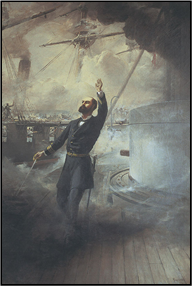
xxxxx…… Thexpainting is by the British-born marine artist Thomas Somerscales (1842-1927), who lived in Valparaiso, Chile, and ran his own painting school from 1874 to 1892. He produced many studies of the sea battles which took place during the War of the Pacific. On returning to England he exhibited at the Royal Academy. ……
xxxxx…… The War of the Pacific, sometimes known as the Chile-Peruvian War, proved a serious setback for the economies of all three countries, and led to political change and periods of internal unrest. It took decades for each country to recover from the expense of the conflict, though Chile did gain some advantage from the acquisition of rich nitrate-mining areas.



 xxxxxThe so-
xxxxxThe so- xxxxxIn December 1880 Chile renewed its military offensive by launching another seaborne attack upon Peru. Approaching Lima early in January 1881, the Chilean army defeated the Peruvians at the Battles of Chorrillos and Miraflores. Their army fled in disorder and the capital city was occupied on the 17th. The Peruvian government was forced to retreat into the highland interior. There followed two years of guerrilla warfare based on this mountainous region, but eventually Peru agreed to make peace. Byxthe Treaty of Ancon, signed in October 1883, Peru lost the province of Tarapaca, and Chile was allowed to continue its occupation of Tacna and Arica for a period of ten years, after which sovereignty would be finally settled by a plebiscite. Atxa truce signed at Valparaiso in April the following year, Bolivia ceded its only coastal region of Atacama Province to Chile -
xxxxxIn December 1880 Chile renewed its military offensive by launching another seaborne attack upon Peru. Approaching Lima early in January 1881, the Chilean army defeated the Peruvians at the Battles of Chorrillos and Miraflores. Their army fled in disorder and the capital city was occupied on the 17th. The Peruvian government was forced to retreat into the highland interior. There followed two years of guerrilla warfare based on this mountainous region, but eventually Peru agreed to make peace. Byxthe Treaty of Ancon, signed in October 1883, Peru lost the province of Tarapaca, and Chile was allowed to continue its occupation of Tacna and Arica for a period of ten years, after which sovereignty would be finally settled by a plebiscite. Atxa truce signed at Valparaiso in April the following year, Bolivia ceded its only coastal region of Atacama Province to Chile -
 xxxxx…… Duringxthe war two naval officers won immortal fame for their bravery and devotion to duty. Admiral Miguel Grau (1834-
xxxxx…… Duringxthe war two naval officers won immortal fame for their bravery and devotion to duty. Admiral Miguel Grau (1834-


